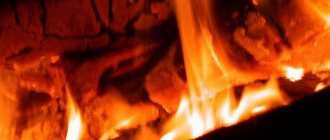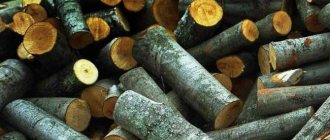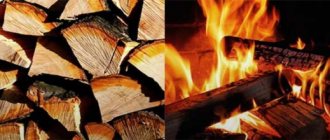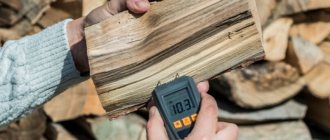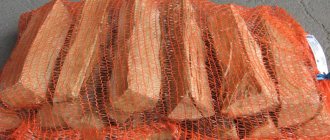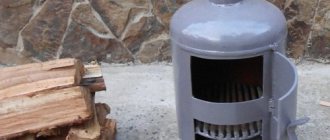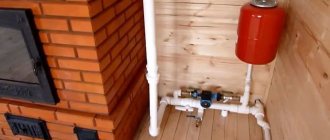Almost every country house has such a necessary attribute as a stove. You can cook on it, and it also heats your home, thereby helping to create a favorable atmosphere in the winter. But sometimes boilers running on different types of fuel are used for heating. At the same time, a logical question often arises: what kind of firewood is best for the stove?
Every private property owner tries to look for fuel at the best price. Gas is a good alternative in this regard, but it is not available in all areas. Electricity is available everywhere, but it is not suitable for a heating system due to the low power of the equipment and the high final cost.
Therefore, wood stoves have been and remain a profitable solution with many advantages. High degree of heat transfer, ease of operation and firewood, the cost of which is relatively low. When the water heating system is not in use, it must be preserved, and this process is not so simple. There are simply no such problems with the stove.
Types of firewood
Even if the heating system includes gas or coal-fired equipment, it is impossible to completely do without firewood. Some connoisseurs of comfort and coziness have a fireplace at home. And to maintain health there is one good and proven remedy - a bath!
But, returning to the question of which firewood is best for a stove, bathhouse or fireplace, it is worth knowing about their varieties. The amount of heat released during combustion depends on how dense and hard the logs are. Knowing which firewood is more efficient for heating a home, you can significantly save on fuel.
People have been using wood for a long time to make fire, which has served various purposes since ancient times: it gave warmth, helped cook food, and scared away uninvited guests. Some trees burn better, producing a lot of heat, while others are poorly suited for heating and emit soot during the combustion process. For this reason, there are types of firewood that are ideal for heating a house or lighting a bathhouse. Others are better placed in the fireplace.
The most popular tree species are:
- conifers (pine, spruce, larch);
- birch;
- alder;
- oak;
- fruit;
- Linden;
- aspen;
- willow.
All firewood is different, and it’s not that some types are better than all others. Each of them has advantages and disadvantages. Let's look at them in more detail, but first a few words about the calorific value of firewood from different types of wood.
Primary requirements
Dry wood flares up and burns well, emits more heat, and smokes less. The logs should not be rotten or saturated with water. Water logs are not suitable for heating stoves.
Good firewood leaves little ash. It is advisable to harvest wood in late autumn or winter, when sap flow stops and the wood is denser.
The size of firewood for the stove depends on the size of the firebox, usually 35-40 centimeters long. The thickness is medium, thick logs split. Small logs are easy to light. They also burn quickly, which must be taken into account when preparing them.
A couple of phrases about calorific value
In terms of its chemical composition, wood is a rather complex material. It contains the main components - lignin and cellulose. But besides them, the tree contains:
- resins;
- proteins;
- tannins and other ingredients.
When logs burn in a stove (or simply when trees burn in a forest), these components interact with the air at a chemical level. The calorific value of wood (as well as any fuel), or thermal conductivity, is the amount of thermal energy that a unit of weight of the fuel material (in our case, 1 kg of wood) produces during combustion. Kilocalories are used to measure quantities.
The chemical composition among most tree varieties has minimal variations, which causes differences in the number of calories emitted. That is, the heat of combustion of some types of firewood can be as follows:
- for deciduous species the figure is 4460 kcal/kg;
- for coniferous species - 4560 kcal/kg;
- for mixed breeds – 4510 kcal/kg.
As you can see, the differences are minimal. At the same time, it is easy to understand that it is better to use coniferous wood for the stove due to its greater thermal conductivity. Only firewood is supplied to the market depending on volume, not weight. That is, the main criterion for choosing firewood is cubic meters. Density plays an important role here, because the higher it is, the heavier the wood.
For example, let’s take 1 cubic meter of birch logs as a starting point. Then the ratio of the volume of different rocks will look like this:
- oak logs - 0.75 cubic meters. m;
- alder logs - 1.1 cubic meters. m;
- pine logs - 1.2 cubic meters. m;
- spruce logs - 1.3 cubic meters. m;
- aspen logs - 1.5 cubic meters. m.
That is, 1 cubic meter of birch and 0.75 cubic meters. m of oak logs, 1.1 cubic meters. m of alder wood (and so on) will produce the same amount of heat. Knowing this, now, depending on how much firewood costs, you can get profitable savings for yourself.
Fuel selection
When choosing the best firewood for a sauna, you may encounter different opinions:
- some recommend buying wood that releases beneficial substances when burned;
- Another group of people is sure that hardwoods are considered the best.
The choice of wood depends on various factors.
Depends on wood density
All types of wood can be divided into 3 groups:
- soft;
- medium-hard;
- solid.
It is better to use hard rocks to fire a sauna stove. They give the strongest heat and burn for a long time. Medium-hard rocks are more difficult to melt and burn for a long time. Representatives of soft breeds are the worst option. They burn quickly, emit intense heat, spark, and crack.
Depending on medicinal properties
The choice of fuel depends on the medicinal properties:
- linden, alder - cleanse the upper respiratory tract of phlegm, remove toxins from the upper layers of the epidermis;
- birch, oak - disinfect bath rooms and help clean the air;
- pine - releases essential oils that are beneficial to the body.
The latter option is less preferable due to the high resin content.
Depends on price
Oak, hornbeam, ash are expensive wood species. People often choose aspen and birch because of its availability and low price. Birch and aspen logs clog the chimney slowly.
When choosing, you need to take into account the moisture content of the material. A suitable figure is 20%.
Some types of wood cannot be stored for more than two years, as they lose their medicinal properties.
Softwood firewood: pine, spruce, larch
By the characteristic crackling of the logs, which literally caresses the ear, and the bright scattering sparks, you can determine the combustion of pine logs. They give off a lot of heat, but burn out quite quickly. But many shortcomings are quickly forgotten thanks to the unique resinous aroma that comes from burning pine or spruce firewood. Only in this case you should be extremely vigilant, since sparks shooting out from time to time can cause a lot of trouble. Therefore, it is necessary to observe safety precautions.
It is worth noting that pine logs produce more heat than spruce logs. Largely due to the high content of resinous substances, due to which the above-mentioned aroma is released. Pine and spruce, it produces an equally invigorating effect. In addition, it can have a tonic effect on the organs of the upper respiratory tract. In addition, spruce logs have a “shooting” effect, while pine firewood has a smoke effect. But the wood of both species splits and melts easily, although it smokes heavily.
As for larch, rarely does anyone light a firebox with such wood due to its low prevalence. It should be taken into account that when logs burn, carbon monoxide is released in large quantities. For this reason, you should not immediately close the damper, and your country house or country cottage should have high-quality ventilation.
Alternative fuel materials
The calorific value of certain types of firewood is quite high, but far from the maximum possible. In order to save money and space for storing heating material, today more and more attention is being paid to alternative options. It is optimal to use pressed briquettes.
The efficiency of using briquettes is several times higher than that of firewood
For the same oven load, pressed wood produces much more heat. This effect is possible by increasing the density of the material. In addition, there is a much lower percentage of humidity. Another plus is minimal ash formation.
Briquettes and pellets are made from sawdust and wood chips. By pressing waste, it is possible to create an incredibly dense combustion material that even the best types of wood cannot compare with. With a higher cost per cubic meter of briquettes, the final savings can amount to a very significant amount.
It is necessary to prepare and purchase combustion materials based on a thorough analysis of their properties. Only high-quality firewood can provide you with the necessary heat without causing harm to your health or the heating structure itself.
Tags: firewood, property, poplar
« Previous entry
Birch - traditions should not be broken
Most people are inclined to believe that such firewood is the best fuel for starting a fire in a fireplace, stove or sauna. And all due to invaluable advantages:
- easy to light;
- burn for a long time;
- the flame turns out beautiful and even;
- no sparks;
- copious heat generation.
But the advantages don't end there. Since ancient times, the healing properties of birch have been known. The pleasant aroma has a beneficial effect on the human body, protecting it from colds and chronic diseases. In other words, birch firewood has a disinfecting effect, which causes approval among those who like to take a steam bath.
When burning, logs emit a small amount of carbon dioxide, and this is certainly a plus. But there is also a minus - a high concentration of tar. And this combustion product is no longer beneficial to health. In addition, soot and soot form on the walls of the stove and in the chimney. As a result, over time, not only is traction lost, but the risk of fire or carbon monoxide poisoning increases. Therefore, when choosing this firewood, it is also worth mastering the profession of a chimney sweep, as well as maintaining safety.
But, despite its shortcomings, birch is the most popular, cheapest and most practical fuel.
Installation recommendations
For a heavy brick oven, it is necessary to build a foundation.
During the installation of a heating device, several rules must be followed:
- Do not place flammable objects or explosive liquids near the heated area.
- It is better to clean the collapsible type of chimney from soot.
- The suitable diameter of the chimney pipe is approximately 15 cm, length – 5 cm.
- The chimney is equipped with an adjustable damper.
- To protect against burns, it is better to use brick shielding. The masonry will also prevent overheating of the walls and will accumulate heat.
- The floor surface made of combustible materials is protected by the foundation.
The complete instructions contain detailed installation instructions.
Alder - a royal gift
If you want to feel like a member of the royal family, you should get hold of some alder logs, because it’s not for nothing that they are popularly called royal logs. They flare up quickly, emit a huge amount of heat, and produce virtually no smoke, which also eliminates the appearance of soot and soot. In addition, logs burn for a very long time. That is, the question of what kind of wood is best to heat the stove in the house has already been resolved!
But the main highlight is the unique aroma, which has a healing effect. It has long been accepted that if you heat a bathhouse using alder wood, you can forget about colds once and for all. Moreover, even in ancient times, it was alder logs that were put into the royal furnaces, as well as the fireboxes of other estates of rich peasants or nobles.
A fresh cut of alder has a red-orange hue, giving the woodpile an unusual and bright appearance. However, there is one interesting feature that everyone should know about. All the benefits described apply to trees that grew in dry areas. If the plants bloomed in the swamp, then there will be soot and unbearable heat.
Alder is especially popular among those who like to smoke meat or fish. Under normal conditions, wood dries quickly, and it retains its healing natural properties for 3 years.
Deciduous
Larch firewood is better suited for heating in the house. The absence of adhesive substances in them does not cause smoke. Some of these rocks are suitable for kindling.
Alder
Alder is treated as the most beautiful firewood. Alder in the cut section has a varied color shade. It depends on where the tree grows. Conveniences include the fact that you don’t need to dry it.
Very expensive firebox material to use for firewood. Oak is economical to use. It is often added to other types of firewood. Due to this, more heat is generated in the combustion chamber.
The fiber structure is more dense. This type is not suitable for lighting a stove.
Birch
Birch firewood provides 30% higher heat transfer than other varieties. They contain tar. Thanks to this, the flame flares up quickly and the heat is maintained for a long time.
Oak - fortress of spirit
Which firewood burns longer? Of course, oak! They are characterized by high strength and density. It is no coincidence that experts jokingly classify this breed as an elite variety, and only then it is valued as a type of fuel. Due to these features, oak logs maintain heat at the required level, produce intense heat, and the negative impact of various external factors does not in any way affect them.
The aroma emanating from the firewood is so pleasant, tart and soft that you can feel the breath of the forest expanses. Like birch, oak can have a beneficial effect on the human body, in particular on the nervous system. It also promotes relaxation and strengthens the immune system.
Wood is long-lived, and finding wood suitable for kindling is not so easy. Not just any logs are suitable for this. Firewood from young plants will not produce much heat, but when old plants burn, a large amount of ash is formed, the air becomes too heavy - not every bathhouse visitor will be able to withstand it.
Heating a house with wood from middle-aged trees works well - they provide just as much heat as needed, or even more. But they are not so easy to find, so oak is rarely used as fuel, and it also grows very slowly.
For reference: once upon a time, good and strong ships were built from oak. Now it is believed that truly tasty and juicy pizza can only be cooked using oak wood. They are also ideal for lighting a fireplace, the only difficulty is that such wood is not easy to split.
Fruit trees for flavor
Of course, no one will specifically grow fruit trees for the sole purpose of using them for firewood. However, there is still an apple, pear, plum or cherry tree on the site. Over time, you can collect a lot of branches and twigs, which you can put into the firebox. Some people make fires right away, but it would be much more correct to carefully cut them and put them in a woodpile. They are ideal for lighting a sauna, since along with a good and even heat, the combustion of wood produces light steam accompanied by a pleasant, delicate aroma.
It costs nothing to saw and chop firewood; the apple tree is the leader in terms of heat release, and there is practically no smoke. But this choice is more of an aesthetic nature.
Aspen – cleaning firewood
Aspen also takes a long time to light and burns out quickly. Therefore, you should not use such firewood to heat the stove, as they say, “from scratch.” At the same time, the flames are long and bright. There are also some other valuable properties. In addition to the fact that firewood itself does not form soot, it is able to remove carbon deposits formed from other logs. At the same time, when compared with birch firewood, aspen logs produce much less heat when burned.
But they can be used to “clean” the chimney. For this purpose, it is recommended to add several aspen firewood at the final stage of the firebox. And the chimney will be “cleaned”. Although they themselves do not produce heat, they are able to maintain heat for a long time.
How to store it correctly?
To maintain the quality of firewood for a long time, you need to ensure proper storage. No special conditions are required for this; a number of points need to be taken into account:
- The woodpile should not be located in a low place where water can accumulate. Otherwise, the wood may rot.
- Logs should be stacked loosely to ensure good ventilation.
- To provide protection from precipitation, a canopy is made.
- There is no need to stack firewood immediately after harvesting. It's better to do this in a few months.
- It is recommended to store it near the house so that there are no difficulties with access to the woodpile.
Light willow logs
If you come across willow firewood in your field of vision, you shouldn’t refuse them. The heat from them is great, the flame is even, and in addition there is no soot. The only drawback is that they burn out too quickly. However, this can easily be compensated for if there are a sufficient number of willow trees in the area where you live. Many landscaping companies don't give them much time to develop. Old trunks are cut down, and branches are removed from still young trees. So you shouldn’t miss any opportunity to profit from such fuel for your home, bathhouse or fireplace.
Coal
I mentioned this type of natural fuel for a reason, because firstly, coal is the most natural wood firewood - albeit very “old”, and secondly, despite the fact that it does not occur naturally on the surface of the earth , they can sometimes be acquired in field conditions - near rural boiler houses (where they are dumped in a heap or even lying on the road) and on railway lines (where they spill out of cars). I know fishermen who have used it many times (especially during the USSR).
- Fire power: 2.79 de.
- Calorific value: 10500 kWh/m³.
- Combustion temperature: 1000 °C.
- Burning time: very long.
- Flame: even, hot, with characteristic smoke.
- Difficulty of lighting: the highest. Under the coal, you will first have to make a small fire from ordinary firewood.
Exotic
As you know, there are quite a lot of tree species, and to list all their types, you could write a thick book, or even more than one.
Therefore, in addition to the varieties listed, it is worth touching on at least a few more:
- Elm. It produces a lot of smoke, is difficult to split and takes a long time to ignite.
- Poplar. Like firewood for a stove - nothing at all. They prick easily, just scatter sparks and burn quickly.
- Beech. It is also difficult to light and split, but can be used raw.
- Fir. Like poplar, it is easy to prick and ignite, but you cannot do without a lot of smoke and sparks.
- Sycamore. Wood is easy to kindle, but difficult to split.
Can they be used for heating in a stove? Everyone can find the answer to this question themselves. But, on the other hand, why not?!
Willow (willow)
It grows en masse along river banks, just like alder - it can be considered fishing fuel. True, in terms of heat transfer it is noticeably worse. It burns out quickly and is only suitable for short-term temporary fires, for example, for producing boiling water or preparing small amounts of food.
- Fire power: 0.56de.
- Calorific value: 2139 kWh/m³.
- Combustion temperature: 480 °C.
- Burning time: short.
- Flame: smooth, with a slight haze, can sometimes spark or shoot.
- Coals: formed in small quantities, burn out quickly.
- Lighting difficulty: easy.
This is important to know!
Regardless of the type of trees that will be used for firewood, you need to know about some features:
- Deadlines. Of course, those logs that have already served their “allotted” time will also burn (provided that they are dry and there is no mold on them). However, most trees retain their aroma only for two years. Alder and aspen are a pleasant exception in this regard - 3 years.
- Everything has its time. In winter, the humidity of trees is at a minimum level. In this regard, the preparation of firewood must be done during this period. Drying usually takes about 12 months. However, the timing depends on the type of forest, harvesting time, storage conditions and a number of other factors. In this case, the duration may increase significantly or, conversely, decrease.
- Dimensions. Which firewood is more profitable? Of course, those with optimal sizes. And these are 40-50 cm in length and 8-10 cm in thickness. This is how they are convenient to store and are suitable for any firebox.
- Rot. Under no circumstances should you use rotten firewood. Keeping logs on the ground for a long time results in the accumulation of toxic substances released during combustion, which is not beneficial to humans. For this reason, when cutting down branches, you should immediately take the correct measures to store them. When choosing raw materials for heating among dead wood, you should not take into account long-fallen branches.
- Storage issues. Logs should be laid with the bark facing up. This will protect the firewood from accidentally entering moisture, which evaporates faster from the surface of the bark. And if you show your imagination, you can build an original woodpile to the delight and surprise of your guests.
As can be seen from this material, it is not enough to know which firewood is best for the stove. It is equally important to ensure that they are stored correctly.
Regarding the arrangement of a woodpile, you can always come up with a lot of different ideas: from the most creative and crazy to the simplest to implement.
What types of woodpiles are there?
There are various forms of stacking logs. You can choose the one that is suitable in this particular case.
Woodpiles can look like this:
- In the form of “sheaves”. It is very convenient to store in this form, since you do not need to build a shed or shed for this. In order to lay out a woodpile in a “stack”, you need to find wood of suitable quality that can be stored for a long time and learn how to stack the logs correctly. Such “sheaves” will last for several years and the firewood will retain its properties. Trellis are placed at the base of such a woodpile. You can lay flat stones or bricks as the base. The main thing is to raise the logs above the ground so that they do not get damp. The base is laid out in a circle, the logs inside are placed in random order. This idea is to ensure that the firewood is well ventilated. A pole is installed in the middle, which will hold the entire structure, from bottom to top.
- This styling looks very aesthetically pleasing. If you put wood of different species in such a “sheaf”, the multi-colored structure will decorate any landscape.
- The second way is in the form of a “fungus”. The stacking method is similar to a “stack”; the logs are split in a special way - not in logs, but in short planks. With the help of such a flat shape, the installation of such a “fungus” is easier. If you want to make the “mushroom” symmetrical in shape, you need experience and time. But this option will be a wonderful decoration for your garden plot.
- The woodshed is compact in size with an original roof. Most often, woodpile designs are made simple, without thinking about the aesthetic appearance. And completely in vain. Woodsheds can not only diversify the landscape, but also divide the area into zones. Compact structures are installed in cases where firewood is used from time to time, not as the main fuel.
- Large woodsheds are storage facilities in which you can store a large number of logs, stocking up for several winters ahead. Externally, such warehouses resemble gazebos, there are cracks in the walls for ventilation of the wood, the roof is reliable and should cover the entire woodpile.
- You can put a woodpile right next to the house. A roof of this design protects the path between the building and the woodpile, that is, snow will not get there. Therefore, getting to the firewood in winter will be easy. The firewood is well ventilated and protected from the sun and precipitation. If you stack the logs in this way, you don’t have to worry about them getting damp or rotting. The construction of such a structure is not difficult. You will need to stock up on wooden blocks or metal corners, a chain-link mesh with large cells, and any roofing material. Floors should be laid with simple tiles, such as those used for sidewalks.
On a note. For good, quick lighting of the stove, firewood is brought into the room in advance so that it can dry in room conditions. For this purpose, special structures are installed near the stove or fireplace, where 1-2 stacks of firewood are placed. This rack is filled as needed.
Folk tales
Superstitions and beliefs circulate among the people. For example, it is believed that it is better to prepare firewood for a bath during the waning moon. Moreover, the thinner the sickle, the stronger the logs are endowed with healing powers. Once upon a time, the Slavs believed that people who left the world turned into maples in their lives. The appearance of its leaves is akin to open palms, and its branches represent hands raised to the heavens. For this reason, they never fired maple stoves.
In the old days, residents of the Tambov province heated their stoves exclusively with apple trees to keep the house warm throughout the winter, including especially frosty days. Whether to believe all this or not is everyone’s business, but what happened was what happened. What do you, dear readers, think: what kind of firewood is better for a stove, bathhouse or fireplace?
Storage rules
Purchased high-quality wood for heating must be properly stored, since moisture reduces the useful technical characteristics. Arranging a place does not require much effort; owners often use the material to create decorative woodpiles of various shapes. Select an area for storing firewood taking into account the following characteristics:
- a dry and elevated place is determined in the yard in which water flows to lower areas;
- stacked firewood is placed loosely so that small gaps between them provide ventilation;
- the wood storage area is covered with a canopy or roof (if this place is not in a barn) to protect it from rain and snow;
- sawn and chopped logs are not collected in a woodpile for 4-6 months after cutting the trunk from the root;
- trees harvested in summer require more time to dry;
- For ease of use, the warehouse is located near the entrance to the house - this will allow you to collect fuel in any weather conditions.
Short firewood eats up useful space, and long firewood does not allow you to close the stove door or place rings. The thickness of the logs is medium in size. The owners prepare the firewood and store it in full for the winter, so as not to have to deal with cutting in sub-zero temperatures.
